
Interesting Facts * The Chanticleer Saga by Jim Hill
Directed by... Marc Davis
INTERESTING FACTS

![]() A children's
book containing the art developed by animator Marc Davis for this never
released feature, called Chanticleer and the Fox (Disney Archives),
was published in 1991. "You can clearly see the influence for his America
Sings / Splash Mountain designs," commented a reader.
A children's
book containing the art developed by animator Marc Davis for this never
released feature, called Chanticleer and the Fox (Disney Archives),
was published in 1991. "You can clearly see the influence for his America
Sings / Splash Mountain designs," commented a reader.
![]() Disney storyman
and sketch artist Bill Peet recalled in a 1997 interview
that "while I chose to do Sword in the Stone, a group of about six
people--Marc Davis, Ken Anderson, Woolie Reitherman, Milt Kahl, etc.--spent
about six months developing a manuscript for Chanticleer, a psychological
drama by Edmund Rostand, the author of Cyrano de Bergerac. There
was a meeting and Milt Kahl said, 'I can draw a goddamned good rooster!'
I said, 'Well so can I, but that's not the problem. The story doesn't come
off for me because its just a little too weird.' They all got pretty angry
with me. I continued working alone on my script for Sword
in the Stone and they started work on Chanticleer.
Months went by and I finally got it together and on the boards. Meanwhile,
Frank [Thomas], Ollie [Johnston], Woolie Reitherman and all the others
were having meetings at night developing a manuscript, plus elaborately
illustrated storyboards, large color pastel paintings and had songwriters
in to write songs and record music. Finally Walt called a meeting to see
what they had done on Chanticleer. They showed it all to Walt. Ken
Anderson asked what he thought and he said, 'Just one word--shit!' Then
he said, 'Let's go see what Bill Peet is working on.' Here come all of
these people into my studio. They were all sulking and hoping I'd fall
on my face. They hadn't spoken to me the entire time. I went through the
storyboards and showed some of the gags with Merlin and the Owl. I showed
Merlin packing everything into one suitcase, which was my own, it wasn't
in the book. When I was done, Walt asked them what they thought--pretty
good, huh? And they said, 'Oh yeah!!' You can imagine how humiliated they
were to accept defeat and give in to Sword in the Stone. The cost
with all those salaries? Too much! No wonder Walt was pissed off. He allowed
them to have their own way, and they let him down. They never understood
that I wasn't trying to compete with them, just trying to do what I wanted
to work. I was in the midst of all this competition, and with Walt to please
too."
Disney storyman
and sketch artist Bill Peet recalled in a 1997 interview
that "while I chose to do Sword in the Stone, a group of about six
people--Marc Davis, Ken Anderson, Woolie Reitherman, Milt Kahl, etc.--spent
about six months developing a manuscript for Chanticleer, a psychological
drama by Edmund Rostand, the author of Cyrano de Bergerac. There
was a meeting and Milt Kahl said, 'I can draw a goddamned good rooster!'
I said, 'Well so can I, but that's not the problem. The story doesn't come
off for me because its just a little too weird.' They all got pretty angry
with me. I continued working alone on my script for Sword
in the Stone and they started work on Chanticleer.
Months went by and I finally got it together and on the boards. Meanwhile,
Frank [Thomas], Ollie [Johnston], Woolie Reitherman and all the others
were having meetings at night developing a manuscript, plus elaborately
illustrated storyboards, large color pastel paintings and had songwriters
in to write songs and record music. Finally Walt called a meeting to see
what they had done on Chanticleer. They showed it all to Walt. Ken
Anderson asked what he thought and he said, 'Just one word--shit!' Then
he said, 'Let's go see what Bill Peet is working on.' Here come all of
these people into my studio. They were all sulking and hoping I'd fall
on my face. They hadn't spoken to me the entire time. I went through the
storyboards and showed some of the gags with Merlin and the Owl. I showed
Merlin packing everything into one suitcase, which was my own, it wasn't
in the book. When I was done, Walt asked them what they thought--pretty
good, huh? And they said, 'Oh yeah!!' You can imagine how humiliated they
were to accept defeat and give in to Sword in the Stone. The cost
with all those salaries? Too much! No wonder Walt was pissed off. He allowed
them to have their own way, and they let him down. They never understood
that I wasn't trying to compete with them, just trying to do what I wanted
to work. I was in the midst of all this competition, and with Walt to please
too."
![]() This ambitious
feature, which went for a while under the working title Chanticleer
and Reynard, was detailed in Charles Solomon's excellent 1995 book
"The Disney That Never Was."
This ambitious
feature, which went for a while under the working title Chanticleer
and Reynard, was detailed in Charles Solomon's excellent 1995 book
"The Disney That Never Was."
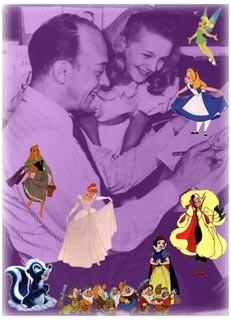
![]() Marc Davis (1913-2000)'s fabulous career spans over 60 years, including
43 years at Disney. In 1988, Marc was officially designated a "Living Legend"
by The Walt Disney Company which is the highest honor that can be bestowed
upon a Disney artist. Many of Marc's creations such as Cinderella, Tinker
Bell, Sleeping Beauty, Cruella de Vil and the beloved skunk Flower are
fond memories for people throughout the world. Disney utilized Marc's humor
and storytelling abilities in many of their most popular theme park rides.
His contributions to It's A Small World, The Haunted Mansion,
and The Pirates of the Caribbean have enchanted millions of visitors.
Marc Davis (1913-2000)'s fabulous career spans over 60 years, including
43 years at Disney. In 1988, Marc was officially designated a "Living Legend"
by The Walt Disney Company which is the highest honor that can be bestowed
upon a Disney artist. Many of Marc's creations such as Cinderella, Tinker
Bell, Sleeping Beauty, Cruella de Vil and the beloved skunk Flower are
fond memories for people throughout the world. Disney utilized Marc's humor
and storytelling abilities in many of their most popular theme park rides.
His contributions to It's A Small World, The Haunted Mansion,
and The Pirates of the Caribbean have enchanted millions of visitors.
THE CHANTICLEER SAGA, by Jim Hill
Article Written in August 2000 by Jim
Hill
Sometimes when they're feeling creatively blocked, Disney animators will go down to the "Animation Research Library" (ARL) and start burrowing through the files. What are they looking for? Images that startle. Drawings that inspire. Pictures that make you say "God, what a great idea! I wish I'd thought of that."
[And] do you know which conceptual art file Disney's artists--top animators like Andreas Deja, even--request to see the most nowadays?
Would you believe it was for a Disney animated film that was to have
featured fowl?

Yep, nearly 40 years before Rocky and Ginger made their great escape
in Dreamworks SKG / Aardman Animation's "Chicken
Run," Disney proposed starring chickens in a feature length 'toon.
But these weren't going to be common English hens. Walt was interested
in exotic birds. Parisian poultry.
What was the name of this proposed film? "Chanticleer." That name alone is enough to make animation historians sigh ruefully. Why for? Because this proposed animated film occupies a very unique spot in toon history. It may just be the best film Disney never made.
What was the problem here? Well, to understand what went wrong with this proposed film, you have to go back to its source material: Edmond Rostand's comedy, "Chantecler." Edmond -- best known today as the author of "Cyrano De Bergerac" -- stitched together a slight story about a vain little rooster who thought that only his crowing could cause the sun to rise. Though it was set in a barnyard, "Chantecler" was actually a sly satire of pre-World War I French society bean. In spite of its satiric underpinnings (or maybe because of them) Rostand's play became a favorite with European audiences -- where it played to packed audiences for years.
Okay, now we jump to 1937. Walt Disney Studios is just about to finish work on their first feature length animated film, "Snow White and the Seven Dwarfs." And Disney is casting about for ideas for the company's next feature length cartoon when someone says "Hey, Walt. You ever hear of that play, 'Chantecler'?"
Walt gets a quick run-down of Rostand's plot and likes what he hears. He particularly thinks that the barnyard setting filled with farm animals will lend itself to lots of great gags for the movie. So Disney puts two of his top storymen -- Ted Sears and Al Perkins -- to work adapting the play to the animation format.
A few weeks later, Sears and Perkins get back to Walt with bad news.
Try as they might, they can't turn Rostand's play into toon material. Ted
and Al gripe that the pre-World War I satire will be too highbrow for American
audiences. More importantly, they just can't come up with a way to make
the proposed film's central character -- the vain rooster, Chantecler --
into a sympathetic character.
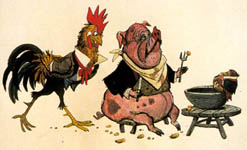
Walt then proposed folding the story of "Chantecler" in with another
French fable the studio was toying with animating, "The Romance of Reynard."
This story -- actually a collection of eleventh century European folk tales
and poems -- featured Reynard, a clever fox who was always tricking greedy
nobles and peasants out of their ill-gotten gold. After all, what better
way is there to make a vain rooster sympathetic than to give him a strong
enemy? Someone like -- say -- a tricky fox?
So Disney's story people took another whack at adapting "Chantecler" to the screen, this time using Reynard the Fox as the rooster's enemy. (About this same time, folks at the Mouse House also americanized the name of the project. Which is how "Chantecler" became "Chanticleer". Anyway ...)
But even with the new villain on board, "Chanticleer" still wasn't quite coming together. Sure, the barnyard setting and the farm animals featured in the story gave Disney's artists plenty of funny stuff to work with. And they produced plenty of wonderful conceptual drawings for the proposed project. But -- in the end -- "Chanticleer"'s story was still very weak and the main characters not terribly sympathetic. So, Walt reluctantly shelved the project.
But -- in the years ahead -- Disney would periodically pull "Chanticleer" off the shelf and ask his artists to take another whack at the material. The project was revived no less than than three different times in the 1940s alone (1941, 1945 and 1947). In fact, many of the drawings done for the late 1940s version of the film provided inspiration for Disney's 1973 animated feature, "Robin Hood" (Which -- not-so-co-incidentally starred a clever fox that tricked greedy nobles out of their ill-gotten gold.)
Still, after all this effort, Disney had yet to turn "Chanticleer" into the makings of a successful animated feature. So -- as the 1950s arrived -- Walt decided to shelve the project for good (or so he thought). He then turned his attention to other more pressing projects -- like Disneyland.
Okay. Now we jump to early 1960. Ken Anderson and Marc Davis have just about finished work on "101 Dalmatians" and they're excited. They know they've produced a film that really moved feature animation into the modern age. Both through its use of the Xerox process to transfer the animator's drawings to cels as well as the film's sketchy layout and design, "101 Dalmatians" is light years ahead of the studio's previous feature, the stodgy "Sleeping Beauty."
And the characters! Thanks to the Xerox process, the artistry and power of the lead animator's original drawings really shines through now. That's why Cruella seems so vibrant, so theatrical. That's Marc Davis drawings in the almost raw you're seeing up there on the screen there.
Marc was eager to build on the theatricality of Cruella. He wanted feature
animation to next tackle a project that would allow Disney's artists to
really go for broke. Swing for the fences. Do something that would dazzle
and entertain a modern audience.
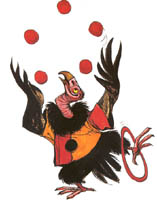
So what did Marc have in mind? Davis -- who was a huge fan of musical
theater -- wanted to do the animated equivalent of a big Broadway musical.
Something with great songs and lots of colorful characters. (Does this
sound familiar, kids? It should. Nearly 30 years later, Howard Ashman and
Alan Menken actually pulled this off when they collaborated with Disney
Feature Animation to create "The Little
Mermaid." That wildly successful 1988 film provided the template for
all the animated projects that follow, "Beauty
and the Beast," "Aladdin," et al. And here
was Marc Davis -- 28 years ahead of his time -- trying to get Disney to
do this very same thing. Life's funny sometimes, isn't it?)
Anywho ... So what does one base a big Broadway- style animated musical on? Well, Marc and Ken looked through all of the stories Disney currently had in development -- but didn't find anything that they liked. Which is how they ended up in the morgue ... excuse me ... "Animation Research Library" ... looking at the studio's abandoned projects.
That's when Marc came across all the great concept art that had been previously done for "Chanticleer." Looking over all these colorful drawings of chickens and Reynard the Fox, Davis had a brainstorm. He turned to Anderson and said "You know, I think we could really do something with this ..."
But first they had to win Walt over to their idea.
When Ken and Marc told Disney that they wanted to revive the "Chanticleer" feature idea, Walt was initially thrilled. After all, he'd been trying to make a movie made out of Rostand's play for over 20 years at this point. But then Disney hesitated for a moment. "What about the plot?," Walt asked. "No one's ever been able to pull a decent cartoon out of this play yet. What are you two going that's finally going to make this thing work?"
"Simple," Marc said. "We're not going to use the play. Ken and I aren't even going to read the play. We'll take the bare bones of the story and just make something up."
It was a pretty audacious way to try and adapt a well-known story to the screen. But Disney loved the idea. (So much so that when the studio began working on a cartoon adaptation of "The Jungle Book," Walt's only advice to the story team -- after tossing a copy of Rudyard Kipling's book in the middle of the story conference room table -- was to say "Here's the novel. Now the first thing I want you to do is not read it.")
So Ken and Marc holed up in an office at Disney Feature Animation for months, doing character sketches and playing with various story ideas. The first thing they did was abandon all the work that the studio had done previously on "Chanticleer." Their hope was that -- by getting a fresh start -- they might be able to come up with something original: a light-on-its-feet satiric cartoon comedy. Something similar to Frank Loesser's 1961 Broadway hit, "How to Succeed in Business Without Really Trying" -- a show that made a lot of clever, pointed jokes but never put them across in a mean spirited way.
The film's hero had to be -- obviously -- Chanticleer, a well meaning but not terribly bright rooster. He -- and all the other chickens that lived in his village -- honestly did believe that the sun came up only because Chanticleer's crowing awakened it every morning. The ladies of the village all swooned at the sight of the handsome young cock. The men in the village all wanted to be his best friend. (Think of Chanticleer as a kinder, gentler version of Gaston from "Beauty and the Beast.")
In fact, Chanticleer is so well liked that the people of the village decide to elect him Mayor. Naturally, all that power goes to his somewhat empty head. So Chanticleer starts nagging the hens to produce more eggs ... which -- of course -- annoyed the ladies.
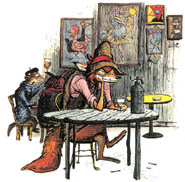 Enter
the villain: Reynard the Fox. A shady character in a battered top hat,
Reynard has a pencil thin mustache and continental charm. But behind those
smooth words and those heavily lidded eyes, this fox is nothing more than
a slick con artist -- always playing the angles, always on the make.
Enter
the villain: Reynard the Fox. A shady character in a battered top hat,
Reynard has a pencil thin mustache and continental charm. But behind those
smooth words and those heavily lidded eyes, this fox is nothing more than
a slick con artist -- always playing the angles, always on the make.
Quickly sizing up Chanticleer's sleepy village as a fruit -- ripe for the plucking, Reynard sweet-talks some of the ladies of the village just so he can learn the lay of the land. The fox quickly ascertains that the chickens are unhappy under the rooster's stern leadership and that the hens long to have a little fun.
That's all Reynard has to hear. He slips out of town, only to return the very next day with his dark carnival. Run entirely by creatures of the night (owls, bobcats, moles, etc.) and birds of prey (vultures), the villagers have never seen anything like it. So the chickens stay up all night -- singing, dancing and playing games of chance. When morning comes, the hens are entirely too tired to lay any eggs.
Chanticleer views the chickens' behavior as civil disobedience, as a direct challenge to his authority. So he orders Reynard and his carnival to leave the village at once. The fox responds by saying that he thinks it's time for a change in leadership in town. That's when Reynard then announces that he's running for mayor of the village.
Alright. I know. This doesn't exactly sound like an award winning plot. And truth be told, it actually gets sillier from this point in: Chanticleer gets suckered into a pre-dawn duel with a Spanish fighting cock. (The Spaniard -- as it turns out -- is secretly working for Reynard.) Chanticleer is so busy trying not to get killed in this fight that he doesn't notice that the sun has risen without his crowing that morning.
After the fight, Chanticleer realizes that he's been a complete ass. He doesn't control the sun anymore than he can control the other chickens in his village. Yet -- because of his sincerity and newly humble nature -- the villagers find it in their hearts to forgive him.
Working together, Chanticleer and the rest of the chickens rid the town of Reynard and his dark carnival. From that point forward, Chanticleer becomes the kind, good-hearted, thoughtful leader that the villagers had always hoped he'd be. Every morning, he still crows -- not to wake the sun, mind you. But to wake his friends so that they can begin yet another day in their beautiful little French town.
Yes. Again, I know. The story sounds silly. Far too thin to support a feature length film. But what you haven't seen are all the great characters Marc and Ken came up with to people this odd little story. Marc drew literally hundreds of concept sketches which show beautiful French hens decked out in their turn-of-the-century finery. Each of the villagers has a hat, coat or cape. Wearing glasses or clutching canes, they stare up at you -- with their bright eyes and wide smiles -- out of the concept sketches and seem to scream: "Animate me!"
These stylized characters -- with their wonderful period costumes and stylized comic design -- would have actually helped Anderson and Davis pull "Chanticleer" off. For Marc and Ken were really hoping to do something ballsy, something original with this film. They envisioned "Chanticleer" as an animated equivalent of a French farce. Something so light on its feet and fiercely funny that you never notice the elephant sized holes in the plot.
Music too would have played a huge part in this film. Marc actually planned for the entire introductory sequence of "Chanticleer" to be done in song. Characters would have entered, literally lugging scenery to help set the stage for the show. Much in the style of Howard Ashman and Alan Menken's "Belle" opening number for "Beauty and the Beast," the villagers would have sung about Chanticleer:
"... We love him so, 'cause he brings the sun up, you know ..."
 The
ironic part of all this was -- as Marc and Ken were laboring to create
a film that would move Disney Feature Animation into the 1960s -- Disney's
accountants were trying to convince Walt to stop making cartoons entirely.
The
ironic part of all this was -- as Marc and Ken were laboring to create
a film that would move Disney Feature Animation into the 1960s -- Disney's
accountants were trying to convince Walt to stop making cartoons entirely.
I know that nowadays -- when an animated feature can make as much as $133 million ("Dinosaur"'s current domestic gross) -- it must sound strange that the Walt Disney Company had ever considered getting out of the animation business. But it's true, kids.
At the time (1960 / 1961), Disney had already produced some 17 feature length animated films. Roy tried to persuade Walt that these were more than enough toon titles to adequately stock the studio's film library. Studies had shown that Walt Disney Productions could release a different cartoon classics ("Snow White and the Seven Dwarfs," "Pinocchio," "Cinderella," et al) each year and still make a healthy profit off the old movies. So there was really no sense in the company wasting any additional moneys making new animated films.
Walt at first strongly resisted this idea. But Roy knew just what cards to play. He had heard that his brother was toying with building another Disneyland somewhere in the United States. Roy also knew that this park -- which was supposed to be at least ten times larger that the original Anaheim project -- was going to be expensive.
"You'd have all the money you needed to get started on your new park," the elder Disney suggested, "if you just shut down feature animation."
Walt again hesitated. For this was truly a tempting offer. All the money he needed to get started on his second park. Plus the cash necessary to fund the project that Disney was really interested in in those days: audio animatronics. Never mind that old, two dimensional stuff in "101 Dalmatians" and "Sleeping Beauty." The three dimensional animated figures that Wathel Rogers and the other guys at WED were working on -- the birds, that Chinaman's head -- that was what really intrigued Walt back then.
Disney had always been a forward thinking guy. He may have loved nostalgia, but he was also eager to tackle new projects, try new things. Compared to audio animatronics, animation did seem kind of old fashioned. But did Walt really dare to shut down Disney Feature Animation?
For weeks, the younger Disney debated the idea with his elder brother, Roy. In the end, Walt just couldn't bring himself to do it. Walt Disney Productions' financial security had initially been built on the popularity of the company's animated movies. To stop making these fine family films entirely would just send the wrong message to the entertainment industry. So it just didn't seem prudent to totally pull the plug.
But what Walt did agree to do was to try scaling back animation production at the studio. Instead of a new animated feature every two years (the pace the company had tried to meet throughout the 1950s), Disney agreed to let Roy reconfigure things so that a new toon would come out once every four years.
The trouble was the studio currently had two animated films in active development: Bill Peet's adaptation of T. H. White's Arthurian fantasy, "The Sword and the Stone" and Marc Davis and Ken Anderson's "Chanticleer." To meet Roy's new animation business plan, one of these projects was going to have to be shut down.
Guess which movie hits the cutting room floor?
Marc knew he was in trouble the moment he saw where Walt was sitting.
Normally -- at pitch meetings like this -- Disney liked to be down front, dead center. Walt wanted to be as close to the action as possible, ready to leap up and act out a funny bit of business or quickly point out where the project had gone off track.
But Walt wasn't sitting down front for the "Chanticleer" meeting. He quietly took a seat at the back of the room and avoided all eye contact with Davis and Anderson. The seats in the front row? They were all taken by "Roy's Boys" -- executives who worked on the financial side of the studio.
Marc and Ken quickly exchanged worried glances. But then, gathering his courage, Davis stepped to the front of the room and began his pitch for the proposed animated film.
No sooner had the phrase: "The hero of our story is Chanticleer, a rooster..." left Marc's lips when one of Roy's boys muttered to his co-horts: "A chicken can't be heroic."
Then Marc knew. 30 seconds into his pitch, "Chanticleer" was already dead in the water. All of Davis's wonderful character sketches. All of Ken's beautifully rendered backgrounds. None of that stuff mattered. This movie was never going to get made.
Still Marc pressed on -- hoping against hope that he could win this audience over to the idea of doing an all-animated Broadway style musical that starred a chicken. No dice. The people attending this pitch session were polite but indifferent. For they knew what Anderson and Davis didn't: That Walt had already canceled "Chanticleer." He just hadn't gotten around to telling them yet.
When the session was over, those in attendance shuffled out silently -- not saying a word.
That includes Walt. Especially Walt.
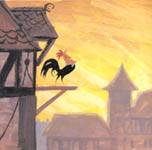
A week went by and Davis nor Anderson heard nothing from nobody. They
just sat in their offices, shell-shocked at how badly the "Chanticleer"
pitch session had gone.
Ken's colleagues at Feature Animation gave these two a wide berth, avoided these two veteran animators like the plague. No one wanted to be associated with a development team that had failed that miserably in a pitch session for a proposed animated feature.
Only Davis and Anderson knew that they hadn't really failed. They were certain that "Chanticleer" -- as they designed it -- would have made a wonderful animated film. Sure, it would have cost a bit more to make, taken a lot longer than "Sword" to produce. But audiences would have loved the finished product.
Only this time around, there wasn't going to be a finished product. For some reason, the accountants -- not Walt -- were now calling the shots at Walt Disney Studios. And that meant an ambitious, expensive animated feature like "Chanticleer" was never going to make it off the drawing board.
What hurt most was not hearing from Walt. Walt -- the guy who'd so strongly encouraged them to take this approach with the material. Walt -- the guy who'd seemed so eager to get a "Chanticleer" movie made. Walt -- the guy who sat in the back of that pitch session and didn't say a word.
For a week, Marc waited by the phone -- hoping that his boss would call and explain what the hell was happening. Why Roy's Boys were suddenly deciding which features Disney's animators could and couldn't make.
Finally, the phone did ring. And -- yes -- it was Walt. But there was no explanation. No apology. Just a job offer.
"Marc," Walt said, "Those guys at WED aren't very good at staging gags. People have been complaining that Disneyland's shows have gotten kind of humorless. Do you think you could go over to Glendale and help them out?"
That was it. No "I'm sorry I let the accountants torpedo your film." No "You and Ken did a really great job. It's just not the right time to make this movie." No "That was the best work you guys ever did. I'm truly sorry that we can't make this movie." Just "Could you go over to Glendale and help those guys out?"
So Marc -- because of his strong sense of personal loyalty to Walt Disney -- went over to WED and helped those guys out. And he never returned to Feature Animation.
But -- In the 17 years he stayed in Glendale working at Imagineering --Davis helped create some of the greatest theme park attractions the Disney theme parks had ever seen: "The Jungle Cruise." "The Enchanted Tiki Room." "It's a Small World." "Great Moments with Mr. Lincoln." "The Carousel of Progress." "Pirates of the Caribbean." "The Haunted Mansion." "The Hall of Presidents." "County Bear Jamboree." "America Sings."
All of them great shows. Each of them displaying that distinctive Marc Davis touch.
But Marc never entirely forgot about "Chanticleer." It was -- to borrow a tired phrase that almost every angler uses -- "the big one that got away." The great film that would have really put a cap on his career as a master animator.
Ah, well ... It wasn't meant to be, I guess.
Mind you, this didn't stop Davis from folding characters and concepts
he created for "Chanticleer" into his work at WED. Take another look at
those singing chickens in "America Sings." Do they look familiar? They
should. Those birds belting out "Down by the River Side" are modeled after
the feathered French hens would who have played the chorus in "Chanticleer."
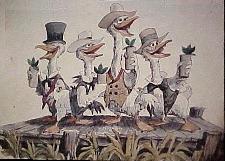 |
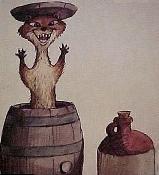 |
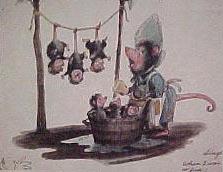 |
And it wasn't just Marc that kept trying to recycle pieces of this proposed film. His character sketches for the aborted 1960s version of "Chanticleer" were so good, they quickly become the stuff of legends around Disney Feature Animation. Artists would repeatedly go down to the morgue (Excuse me. "Animation Research Library"), pull out the full color, beautifully rendered drawings Marc made for the movie and just marvel at them.
These drawings were so good -- in fact -- that veteran Disney animator Mel Shaw pulled them out in 1981 to try and sell Disney management on the idea that it was finally time for the studio to make "Chanticleer." Hoping to improve the proposed project's chances, Shaw worked up a story treatment that stressed the rooster's heroic qualities -- making him "the most MACHO (chicken) in all of France."
Mel also threw together an inspiring set of pastel and watercolor conceptual drawings as he tried to sell the studio on making his vision of the film. But the folks running Walt Disney Productions in the early 1980s were more cautious and conservative then "Roy's Boys" were back in 1960. They quickly shot down the idea of the studio ever doing "Chanticleer" as a full length feature.
When word got out that Disney had once again rejected the idea of doing "Chanticleer" as an animated feature, one man rejoiced. That man's name? Don Bluth.
Two years earlier, Bluth had made a very public break from the animation operation at Walt Disney Productions. Tired of the heads of the studio constantly cutting corners, always going for the safer choices, Bluth -- one of the most talented young animators Disney Studio had at the time -- bailed out of Burbank. He left his cozy corporate nest, taking 15 or more of Disney's top young animators with them.
These folks started a new animation studio, "Aurora Productions." Their mission: to make great animated films like Walt used to do. Movies like "Pinocchio" and "Bambi." With strong storylines and full animation. Not tired, half-hearted films like "Robin Hood" and "The Aristocats."
Right out of the box, Aurora Productions did make a great animated film. Maybe you've seen it ... "The Secret of Nimh?" This film has everything a hit movie should have: A solid, moving story with superb animation. Characters you care about. Big laughs. Great action sequences. A beautiful score.
Yep, "The Secret of Nimh" had everything that a hit film should ... everything except an audience. In spite of receiving tremendous reviews, "Nimh" really didn't do all that well at the box office and quickly faded from sight.
But still -- buoyed by those great reviews (as well as those encouraging phone calls from Spielberg and Lucas) -- Bluth remained hopeful. Maybe someday -- if he played his cards right -- Don might get his shot at turning "Chanticleer" into a great animated film.
For -- during his 10 year long tenure at the Mouse House -- Bluth too had been down to the morgue (Aw ... forget it!) and seen Marc's drawings. That's why he knew that a truly fine animated film could be pulled out of Rostand's barnyard comedy.
10 years later, Don did get his chance at turning "Chanticleer" into a feature length animated film. And while it would be nice to report that Bluth did want Disney couldn't: turned this French satire into a successful cartoon ... that's not exactly what happened, kids.
What went wrong? Well, for starters, Bluth's version of "Chanticleer"
-- entitled "Rock-a-Doodle" -- moves the
story to America and turns this French vain rooster into ... well .. sort
of a feathered Elvis.

Then there's the problem with the villain. Bluth knew that if he borrowed
Disney's proposed antagonist -- Reynard the Fox -- that it would be too
obvious where he had cribbed his original source material from. So Bluth
opted to create an all new villain for his "Chanticleer" cartoon: the Grand
Duke (voiced by Christopher Plummer), an owl who wanted Chanticleer out
of the way so that the sun would never rise again and the world would be
forever shrouded in darkness.
Alright, so that's exactly not the greatest motivation for a movie villain. There's still lots to like about Bluth's "Rock-a-Doodle." Mouse fans will be pleased to hear that old Disney favorites like Phil Harris and Sandy Duncan provide voices for characters in the film. And -- as a sly tribute to the original author of "Chanticleer," Edmund Rostand -- Don named the little boy/cat who drives the action in the movie Edmund.
Unfortunately, audiences in April 1992 (when "Rock-a-Doodle" finally made its stateside debut) weren't feeling as kindly toward Don Bluth as I did. They greeted the film with indifference. "Rock-a-Doodle" got lousy reviews, did terrible box office and quickly sank like a stone.
So -- since Don Bluth Productions turned out such a mediocre "Chanticleer" movie -- that's the end of the story, right? No one will ever again attempt an animated version of Rostand's play, correct?
Not necessarily.
Modern Disney master animator Andreas Deja remains a huge fan of Marc Davis' conceptual work for "Chanticleer." In Charles Solomon's great book about Disney animated features that never quite made it off the drawing board, "The Disney That Never Was," (Hyperion Press, 1995), Deja is quoted as saying:
"Marc designed some of the best looking characters I've ever seen -- these characters want to be moved and used."
Deja's obsession with this material continues to this day. This past April -- as part of the "Tribute to Marc Davis" that was held at the Samuel Goldwyn Theater in Hollywood -- Andreas took a few moments to show the crowd some of Marc's drawings from "Chanticleer." As he looked up at the images on the screen, Deja remarked:
"It's kind of sad that this movie was never produced; the studio decided
to do 'Sword in the Stone' instead.
Which is also a very good movie, but wouldn't it have been nice to see
these characters come to life? Apparently, at that time, the studio felt
-- according to Marc -- that it would be too difficult to develop sympathy
for a chicken. I don't think so. I have sympathy for these guys."
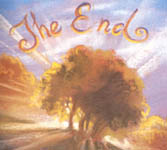
He added, while still looking up at the pictures, "One of these days,
I'll have to sit down and do a few pencil tests of these characters --
just to see them move."
So there you have it, kids. Fowl fans rejoice! Particularly now that Dreamworks SKG had a huge hit this past summer with Aardman Animation's "Chicken Run." Maybe someday Deja will put together a test that finally convinces the accountants who are running the Walt Disney Company that there's a great film to be made from Marc Davis' "Chanticleer" conceptual material.
Here's hoping, anyway.
|
||||||||||||